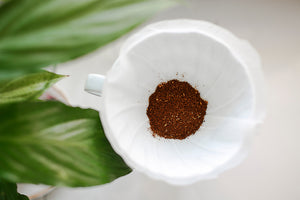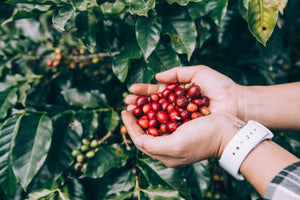
A History of London Coffee - Part 5 of 5
In our history of London speciality coffee, we’ve reached the exciting times of 2010 and part 5. If you haven’t, you really need to read part one covering pre-millennial cafes, part two which leads up to 2007, part three describing the birth of Square Mile and the years 2007 and 2008, and part four on the 2009 London scene.
By the end of 2009, cafes open in London included Monmouth, Fernandez and Wells Beak Street, Flat White, Milk Bar, Climpson & Sons, Nude, Taylor St, Prufrock at Present, Colombia Road, Pitch 42, Taste of Bitter Love, Lantana, Flat Cap, Electric Coffee, Pavilion, Dose, The Espresso Room, the Exchange stall, Look Mum No Hands, Kaffeine, Tina We Salute You, Browns of Brockley, LJ Coffee House, Beas of Bloomsbury (back then when it was actually owned by Bea Vo), Fernandez and Wells St Anne’s Court, Wilton Way, Ginger and White in Hampstead, Wild and Wood on New Oxford Street and the London Review of Books Café alongside a handful of others. Filter coffee was rare and the handful of good places served Monmouth, Square Mile, Climpson and Sons, Nude or Union.
2010: The rise of other brewing methods
In February 2010, Charmaine Mok produced a London Coffee Guide in Time Out magazine (which back then people actually paid for) which showed just how quickly the independent coffee scene had been growing. It helped a great many find good coffee although it suffered the fate of trying to be balanced geographically at a time when only Electric Coffee were worth visiting in West London and many areas lacked good coffee options, but it was a sign that people were paying attention to the growing scene.
One development on the scene was that Fernandez and Wells switched from Monmouth to a custom roast from Hasbean in April, providing a regular London outlet for Steve Leighton’s roasts in London. The new St Anne’s Court espresso bar (now closed) was later to be manned by David Robson (Soho House, Association, Prufrock etc) and James Bailey (Workshop, Prufrock etc.)
Tapped and Packed launched in April 2010 with little fuss or attention. We literally stumbled across them during their opening week and met Matthew Robley-Siemonsma behind the bar. Not only did they provide coffee from a range of roasters (back then Square Mile, Union, Has Bean, Union, James Gourmet, Extract and others) they also featured other brewing methods than espresso on a coffee menu. Both were changes of emphasis, the former allowed Tapped and Packed to function more as a ‘free house’ and offer a variety of coffee; the latter allowed the emphasis to be on a variety of subtle flavours available in the single origin coffees. The latter introduced espresso-weaned Londoners to the likes of the exotic Woodneck, V60, siphon and Aeropress. Both changes were hugely influential.
Tapped and Packed featured forward thinking young baristas such as Victor Frankowski, Rob Dunne, Matthew Robley-Siemonsma (Prufrock) and Sang Ho Park (Square Mile) and in July 2011, Tapped and Packed opened their second cafe ‘114’. To be fair Dose Espresso probably offered Aeropress coffee before this time and Monmouth had been offering filter coffees for many years (with less attention to detail) but London speciality coffee had always focussed on espresso so this was a breakthrough.
Many of the best cafes had now switched to Square Mile beans and Square Mile created a pop-up shop that opened a few eyes and a few taste buds to a new direction – no milk, no sugar, no espresso. Penny University on Redchurch Street opened in May 2010 and blew many minds with a coffee-sommelier approach and emphasis on single origin filters brewed by hand. To a coffee crowd weaned on espresso blends, this was exciting and new. Even if it opened now, it would be radical.
Penny University was named after the coffeehouses of 18th Century London where customers paid a penny to enter and then drank coffee at will. In these places news was exchanged and announced, conversations raged wildly and philosophers held court. In Square Mile’s version, a very limited number of seats were available, all at the bar, and we were talked through the coffees by expert sommelier-baristas. Usually around four single origin coffees were available, each with a suggested brewing method. The visual theatre of siphon was always exciting of course but I really remember the approach of the baristas, encouraging us to smell the ground beans, discuss the origin of the beans, and encouraging us to wait several minutes before drinking the brew. This personalised sensory experience must have set many on the path to coffee obsession.
Caravan was launched on Exmouth Market in 2010 and was something new: a restaurant that cared about the coffee and incorporated their own roaster downstairs. The roasting and sourcing at Caravan gradually developed from humble beginnings to become the world-class roasters they are today but even back then, their vision was very strong – it is no surprise that the Caravan brand has become as successful as it has. Credit has to be given to chef Miles Kirby and co-owners Laura Harper-Hinton and Chris Ammermann and all the quality staff that have played a part in Caravan’s success story. Caravan celebrate their 7th birthday on 17th February 2017.
After the three successive UK based World Barista Champions it was exciting to host the WBC in London in June 2010. Mike Phillips from Intelligentsia in the States came away the winner, later going on to found Handsome Roasters in LA before being incorporated into Bluebottle. The impact on the London scene was that the profile of speciality coffee was raised and many coffee drinkers continued their education. Money was also raised for the Coffeekids charity. A print map was produced of the London scene at that time featuring a grand total of 30 cafes. The WBC was held in Olympia, ironically then many miles from a decent coffeeshop.
The development of the London scene had been watched closely in New Zealand and late in 2010 AllpressRoasters arrived in London with their roaster/café on Redchurch Street. It was interesting that roasters like Allpress (and later Ozone) came in with their Kiwi roast style quite different from the medium-light roasts becoming popular in London. It would add to what was in the following year to become a more diverse scene in terms of roasteries used.
Of course the highlight of the year was in November 2010, when London’s Best Coffee smartphone app was launched with an elegant and functional design and an interactive rating system. Creator Derek Lamberton worked hard to keep up with and review all the latest developments.
One of those, the other really significant happening in late 2010, was the opening of Notes Music Coffee (now Notes) in a former record store in Covent Garden. The CDs and DVDs remained back then but combined with a new cafe of ambitious design. Fabio Ferreira and Robert Robinson hired key staff such as Ben Drury and Candice Madison who knew how to make great coffee and engage their customers. The brew bar was a significant feature where those interested could sit and engage with the staff while streams of customers from the nearby Coliseum Theatre and the Trafalgar Square galleries would create waves of intensity. The cafes opened late into the evening and soon added an evening emphasis on wine. This allowed Notes to function as more of a cafe in the daytime and a winebar in the evening. Another key aspect, as with Tapped and Packed was the use of more than one roaster.
Meanwhile that year, Brewed Boy (Rob Lockyear later of Allpress) told Soho stores while selling coffee from his cart in Rupert Street and nearby streets, Coffee Circus opened in Crouch End and Federation in Brixton. Taylor Street Baristas opened a second café in the city – Old Broad Street –serving a serious quantity of Union coffee and Kurt Stewart and Olaf Wiig founded Volcano Coffee Works, roasting in Crystal Palace.
Store Street Espresso was opened in October by Roger Hart (a café manager and former trainee nurse at Kings College) and Jack Hesketh (a biologist from UCL). They opened the café while working on his PhD and Store Street has attracted loyal customers through consistency, innovation (among the first to bring in batch brew, cold brew, art in cafes, matcha, guest espresso and public cuppings) and great hospitality. It helps that whenever staff turnover demands, Jack and Roger still step up for a barista shift.
As we waited with baited breath for the much talked about impending opening of a huge (by standards then and now) new Prufrock Coffeeshop in a former adult bookstore in Leather Lane, a new coffeeshop opened right opposite. Department of Coffee and Social Affairs on Leather Lane went on to become an important London chain.
Well, we’ve just reached the end of part 5 and there seems a lot more to cover. We promised 5 parts and we delivered but perhaps another volume might be needed along the way. 2011 was pivotal. Prufrock opened on Leather Lane, St ALi on Clerkenwell (later to become Workshop), guest coffees became more common and architect/designer Hoi Chi Ng opened Coming Soon coffee in the Golden Lane Estate near the Barbican, serving up then radical single origin espressos on a lever espresso machine. All that and coffee wizardry and sensory creativity from Dunne Frankowski at Protein.
by Phil Wain - Former Editor



